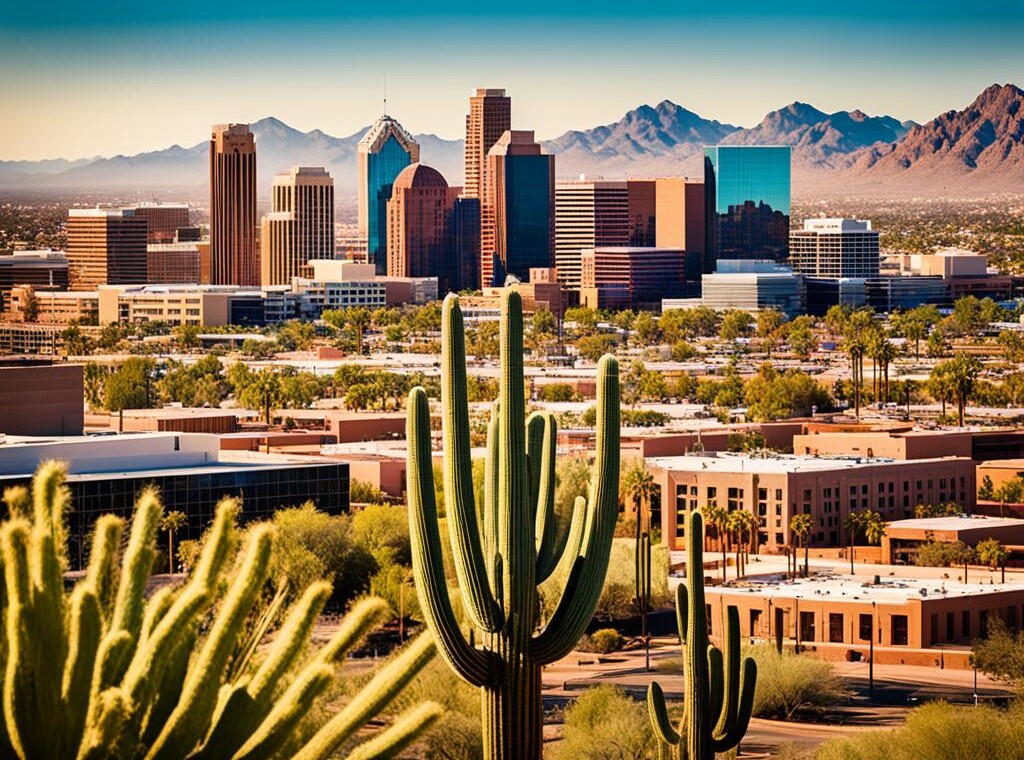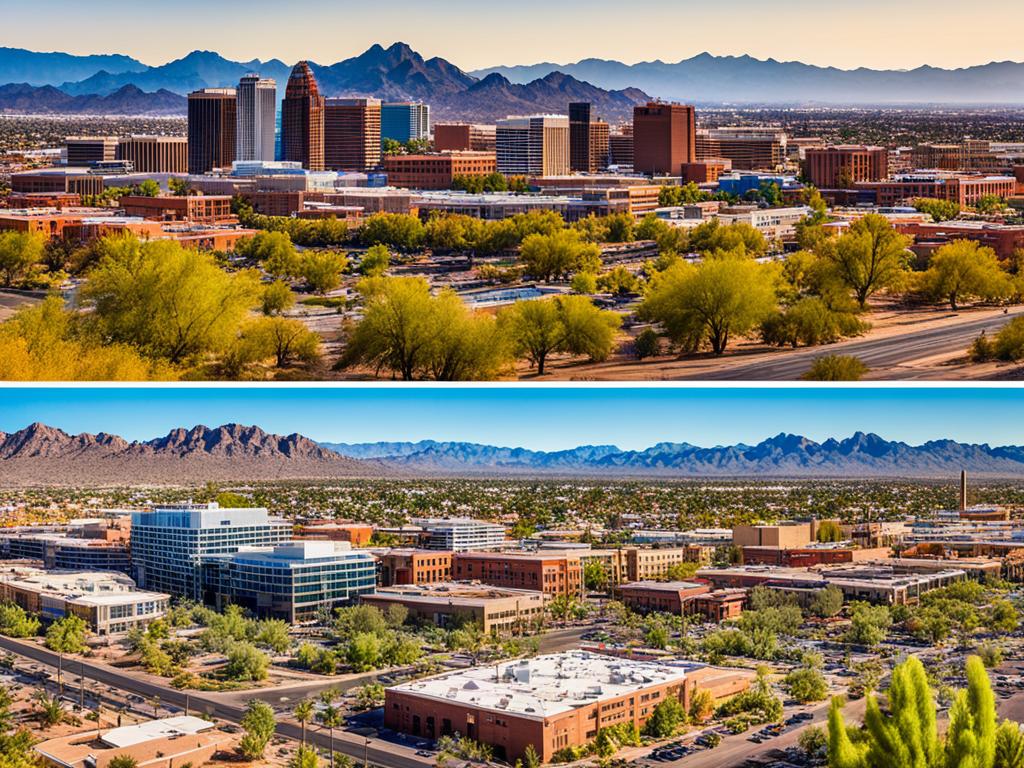Planning a Phoenix Vacation: Tips and Tricks
- 07/15/2024
- Activities, Places
Discover the best travel planning tips for an unforgettable Arizona vacation. Make your Phoenix tourism experience exceptional with our guidance. Read More
This website uses affiliate links, which may earn us a small commission at no extra cost to you. Learn More...

Are you curious about Phoenix’s captivating past and vibrant culture? This city has a story that spans from ancient times to today. Join us as we explore Phoenix’s rich history and diverse culture. You’ll get a peek into what makes this place special.
The Hohokam people were key in shaping Phoenix’s history. They lived from 450 AD to 1450 AD in the Phoenix Valley. They left behind a legacy of engineering and culture.
Mesa Grande Cultural Park shows the Hohokam’s architectural skills. A temple mound from 1100 AD to 1400 AD stands there2. It shows their religious and ceremonial life.
Learning about the Hohokam people helps us appreciate Phoenix’s Indigenous roots and their lasting impact.
Located in Papago Park, Governor Hunt’s Tomb is a key spot in Phoenix’s history. It’s a pyramid tomb above ground, where Arizona’s war governor, George W.P Hunt, rests. It’s perfect for those who love history and architecture.
The tomb was built in 1932, showing Phoenix’s link to ancient Egypt and the pyramid craze back then. Its design and details are striking, making it a key landmark in Papago Park. It draws visitors from across the country.
Set in Papago Park’s beauty, the tomb offers a peek into Phoenix’s architecture and stunning city views. While there, enjoy the peace and the amazing views of the park.
At the tomb, you get to learn about Phoenix’s history and its influential people. Inside, you’ll find out about Governor George Hunt’s long rule in Arizona. This adds to your knowledge of the city’s politics and culture.
Make sure to take photos of Governor Hunt’s Tomb and Papago Park. These pictures will remind you of your visit. They’ll show off Phoenix’s architectural beauty.
Keep exploring Phoenix’s history and culture. Learn about the Hohokam people and their ancient ways, or the cool sleeping porches. There’s much more to see in this lively city. Start an adventure that shows you Phoenix’s hidden gems and its rich past.
Before air conditioning, Phoenicians used sleeping porches to stay cool at night. They moved their beds outside to catch the breeze. This way, they enjoyed fresh air and avoided the heat indoors.
The Rosson House in Heritage Square is a great example of this. Built in 1895, it’s a Queen Anne Victorian house with a sleeping porch. It shows how early Phoenix residents beat the summer heat.
Heritage Square in downtown Phoenix is full of historic buildings, like the Rosson House. It lets visitors see how the city used to be and learn about its history.
As air conditioning became widespread after World War II4, many sleeping porches were changed. They were turned into indoor spaces. But, the love for outdoor living in Phoenix’s mild winters stayed, shaping the city’s culture.
Thinking of making your own sleeping porch? Experts suggest bug protection for a good night’s sleep. Also, comfy seating, the right lighting, and a nice color scheme make the space welcoming and relaxing4.
The Arizona State Capitol Museum in Phoenix shows the state’s political history and Phoenix’s importance. It’s at 1700 West Washington, Phoenix, AZ 850076. The museum has 71 pages of info on Arizona’s history, government, and capitol6. You can take guided tours at 10:00 a.m. and 2:00 p.m6., lasting about 45 minutes.
The museum is open Monday to Friday, 8:00 a.m. to 5:00 p.m., closed on state holidays6. It has lots of resources, like a history bibliography and a booklist for kids6. If you like history or want to learn about Arizona’s capital, the Arizona State Capitol Museum is a great place to visit in Phoenix.
The historic Adams Hotel is in downtown Phoenix’s heart. It was built in 1894, making it the first luxury hotel in Phoenix. Guests like presidents and celebrities stayed there, making it a social spot7.
A fire destroyed the hotel in 1910, but it was rebuilt in 1912. The new building was made of fireproof concrete and had a Mission Revival style. It was ready for Arizona’s statehood celebration, continuing to be a key spot for events7.
Today, the hotel is the Marriott Renaissance Phoenix Downtown Hotel. It keeps the old hotel’s spirit and charm. It’s a symbol of Phoenix’s history and growth7.
Under the hotel lies Melinda’s Alley, a speakeasy. It’s in the basement where the hotel’s history began. Now, it’s a place for Prohibition-era culture7.
At Melinda’s Alley, look around and see the hotel’s art and details. Then, explore downtown Phoenix’s culture and history. You’ll find a 70-foot mural and Heritage Square, with old brick homes8.
Don’t miss Pizza Bianco by Chris Bianco, near Heritage Square. It’s famous for its wood-fired pizzas. People from all over love it8.
For Southern food, go to Mrs. White’s Golden Rule Cafe. It’s in a simple building but serves amazing Southern dishes. It’s a must-visit for food lovers8.
The Phoenix Art Museum is great for art fans. It has a cool installation by Yayoi Kusama. It’s an experience that mixes reality and fantasy8.
The Japanese Friendship Garden is perfect for peace. Walk through beautiful gardens and enjoy the calm. Don’t miss the tea ceremonies for a taste of Japan’s culture8.
The Crescent Ballroom is fun for live music and events. It can hold 550 people and has trivia and open-mike nights. There’s always something happening8.
The Monarch Theatre is great for dancing and events. It has an outdoor dance floor and hosts various events. It’s a place for a fun night out8.
Phoenix, the vibrant city we know today, has a rich history. It almost had a different name, like Pumpkinville, before becoming Phoenix9.
The name Phoenix means renewal and rebirth. Pioneers chose it to honor the past and look forward to the future. They built on land once home to the Hohokam people, honoring their legacy10.
Phoenix’s name is just part of its story. In 1868, Jack Swilling started the Swilling Irrigation Canal Company. This was the start of the city’s growth potential11.
On May 4, 1868, Phoenix was officially recognized as a settlement. This was the start of a new chapter, leading to growth and development11.
Soon after, on June 15, 1868, the first post office opened in Phoenix. Jack Swilling became the postmaster, connecting the city to the nation11.
The first steam mill in 1869 marked Phoenix’s industrial progress. This mill helped the growing community and supported economic growth11.
By 1870, Phoenix was a center for education, with 379 students in school11.
In 1880, Phoenix was thriving with a population of 2,453. Maricopa County, where Phoenix is, had its first legal hanging that year11.
On February 25, 1881, Phoenix became an official city. This was a key moment for its development11.
Just a few months later, on May 3, 1881, Phoenix held its first election. John T. Alsap was elected mayor, starting local governance11.
The journey from Pumpkinville to Phoenix was filled with vision and hard work. Today, Phoenix is a thriving city, the 11th most populous in North America9.

Phoenix’s aviation history goes beyond Sky Harbor International Airport. Air Haven, a forgotten airport, played a big role in the city’s early aviation. It was a key spot before Sky Harbor became famous.
Many went on their 8th-grade graduation trips to Disneyland using Tom-Wat, a popular way to travel12.
Phoenix’s aviation scene was more than just Sky Harbor. Air Haven showed the social and entertainment trends of its time. People wanted to stand out and be noticed, just like icons like Michael Jackson and John Lennon12.
“Air Haven was a gateway to the world of aviation for many in Phoenix. It was a place where dreams took flight and memories were made,” recalls a former Air Haven employee.
Air Haven may not be an airport anymore, but its legacy lives on. A Costco now stands where Air Haven once was, connecting people to the city’s aviation past.
Visit the aviation museum at Sky Harbor International Airport to learn more about Phoenix’s aviation history. See exhibits on the history and progress of aviation in Phoenix, including Air Haven.
Discover the secrets of Phoenix’s forgotten airport, Air Haven. Learn about the city’s aviation history from the 1970s and 1980s arcade games to the rise of Sky Harbor International Airport. Phoenix’s story is one of innovation, dreams, and progress.
The Hancock Store was Phoenix’s first building13. It was more than just a store; it was a meat market, town offices, and county offices too. This place was the center of activity in the young city. Though the original building is gone, CityScape now stands at 1st St. and Washington, marking the spot where the Hancock Store once was. Visiting CityScape lets you follow in the footsteps of Phoenix’s pioneers.

At South Mountain Park Preserve, there’s something for everyone. It has over 50 miles of trails for hiking, biking, and horseback riding15. Whether you want a calm walk or an exciting journey, the park has trails for all levels1415. You’ll see beautiful views and landscapes that show off Phoenix’s natural beauty as you explore.
The Judith Tunell Accessible Trail is great for everyone, thanks to its design for accessibility14. It has signs along the way that teach you about the park’s plants and animals14. The Holbert Trail is another highlight, offering views of downtown and ancient petroglyphs14. For a bigger challenge, the National Trail stretches 14 miles and has stunning views and varied landscapes14.
South Mountain Park is full of wildlife, like jackrabbits, cactus wrens, and Gila monsters14. It’s a place where nature lovers can dive into the Sonoran Desert’s beauty.
The park is also home to the iconic saguaro cactus. These cacti can live over 200 years and bloom with magical white flowers at night14. Seeing these saguaros is an unforgettable experience that shows off Phoenix’s unique nature.
Congratulations on starting your journey to learn about Phoenix’s history and culture! You’ll find fascinating stories and traditions that have made Phoenix what it is today.
Phoenix’s story begins with the Hohokam people, who built an amazing irrigation system. Today, it’s the fifth largest city in the United States16. Its history is full of resilience, growth, and adapting to new challenges.
So, bring your curiosity and start discovering Phoenix. Dive into museums, connect with locals, and soak up the city’s culture and heritage. By doing so, you’ll develop a deeper love for Phoenix’s past and present. This connection will last with you for many years18.
To learn about Phoenix’s history and culture, check out museums, landmarks, and local events. The S’edav Va’aki Museum sheds light on the indigenous Hohokam people. The Arizona Capitol Museum offers insights into the state’s politics.
Heritage Square and CityScape showcase early architectural wonders. South Mountain Park connects you with the city’s outdoor past.
Governor George Hunt’s Tomb in Papago Park is a pyramid tomb. It links Phoenix to ancient Egyptian culture. The tomb highlights the city’s interest in pyramids back then.
Papago Park also offers breathtaking views of Phoenix, making it a favorite spot for visitors.
Visit the Rosson House in Heritage Square to see Phoenix’s cooling techniques. This Queen Anne Victorian house had a sleeping porch to stay cool before air conditioning. Heritage Square and its museums offer a peek into the past and the city’s early ingenuity.
Phoenix was almost named Pumpkinville, Salina, or Stonewall. But it was named Phoenix for its symbol of renewal and rebirth. The name reflects the community’s hopes for the future on the site of a past civilization.
Before Sky Harbor International Airport, Air Haven was a hub for crop dusters and private planes. Now, the aviation museum at Sky Harbor gives insight into Phoenix’s aviation evolution and its role in transportation.
The Hancock Store, Phoenix’s first building, is gone. But CityScape at 1st St. and Washington now stands where it once was. CityScape lets you walk in the footsteps of Phoenix’s early settlers and learn about its history.
Visit South Mountain Park to embrace Phoenix’s natural beauty. It’s a huge municipal park with mountains and trails. It’s perfect for hiking, horseback riding, and enjoying the outdoors.
Learn about Phoenix’s history and culture by visiting museums like the S’edav Va’aki Museum and the Arizona Capitol Museum. Don’t miss landmarks like Governor Hunt’s Tomb and the Rosson House. Local events, traditions, and South Mountain Park also offer insights into Phoenix’s heritage.
Follow us on Facebook and Instagram for the latest updates and exclusive content! Join our community now!

Discover the best travel planning tips for an unforgettable Arizona vacation. Make your Phoenix tourism experience exceptional with our guidance. Read More

Discover top relaxation and wellness activities in Phoenix to rejuvenate your mind, body, and spirit. Explore local spas, tranquil yoga studios, and... Read More

Craving exceptional dining experiences? Find out where to discover the best restaurants in Phoenix and immerbrate yourself in the city's vibrant food... Read More

Stress-free travel starts here.
We simplify and transform every aspect of your travel planning so you can focus on the excitement of your journey. Our platform is designed to provide essential travel resources, tips, and insights, ensuring a stress-free travel experience. More About Us
Copyright© 2024 HightVoltageArea – All rights reserved.
Log in
Don't have an account? Register
Please enter your username or email address. You will receive a link to create a new password via email.